

Regular readers of The English Apple Man will be aware of the efforts of Theresa Huxley as she endevours to attract young people into the fruit industry
Last Friday (25th January) in excess of 60 members of the fruit fraternity gathered at Hadlow College for an in depth discussion and practical pruning demonstration.
The event was a culmination of Theresa's enthusiasm and drive over the last three and a half years; her determination to maximise the capability of the UK Top Fruit Industry and her determination that the opportunities for students is maximised, is in keeping with her passionate support for UK produce.
Under the guidance of Roger Worraker, several growers and industry experts imparted theoretical and practical guidance to the Hadlow Students.
After an introduction by Sarah Morgan - Faculty Manager for Horticulture Design & Landscape and an eloquent welcome from Hadlow Principal Paul Hannan; Theresa Huxley encouraged the Hadlow Students to take full advantage of the opportunity to learn from the many industry experts present. She also thanked Hadlow College for organising this event and John Breach and his suppliers of trees and stakes for their generous contribution to this excellent educational opportunity.
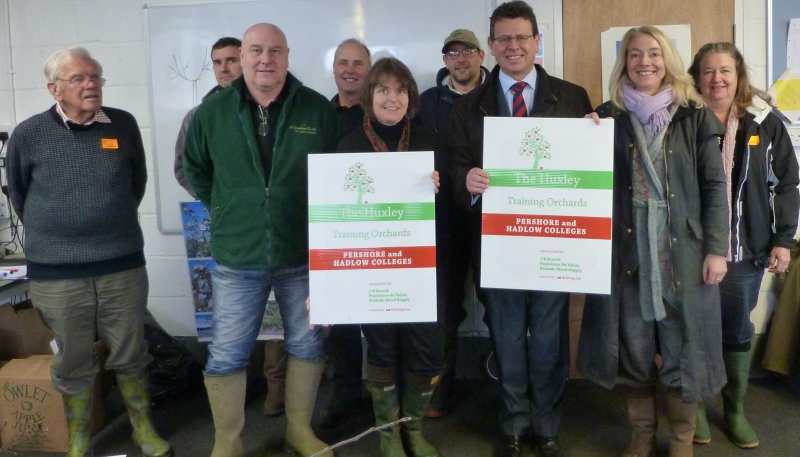
Above; Front row. L-R. Roger Worraker, Nigel Stewart (AC.Goatham) Theresa Huxley (Sainsburys) Paul Hannan, Sarah Morgan (Hadlow College) Behind; Robin Bickley, John Edgeley, John Falmer & Julia Page (all Pershore College)
Roger reviewed the individuality of 'variety pruning characteristics' with an empathy for the subject only a man of great practical and tutorial experience can impart!
Addressing the Hadlow Students, Roger said "think about the trees and what you are going to do". First the framework, second the cropping units. Over the last 50 years the structure of the trees has changed, from Bush trees with their upturned 'wine glass' shape, then the advent of Spindle bush with the central leader integral to the tree structure and a defined base of three or four branches, and now with trees planted very close; the intensive single row system, which has evolved into a Fruit Wall.
Supporting Roger; Malcolm Withnall, who is Senior Lecturer in Horticulture at Hadlow specialising in RHS Courses, from Certificate to Masters (their degree offer). Malcolm has a lifetimes experience within the fruit industry and has tutored at Hadlow College over a period of 20 years.
With a combination of 'white board' illustrations and fruiting laterals from the different varieties, e.g. Cox, Gala, Egremont Russet each with its own characteristics; some only cropping on 2 year old wood (Cox) while others cropping freely on one year old wood (Gala), Kanzi, Braeburn and some 'tip bearers' like Bramley and Discovery.
They all start life as a Feathered Maiden Tree from The Nursery.
BUSH TREE SHAPE
The bush tree shape, which is essentially an 'open centre tree' very much like an upturned wine glass, starts life as a well feathered maiden tree (one year old) and by removing the centre leader, we force the stronger laterals into a position which can be trained into the bush tree shaoe.
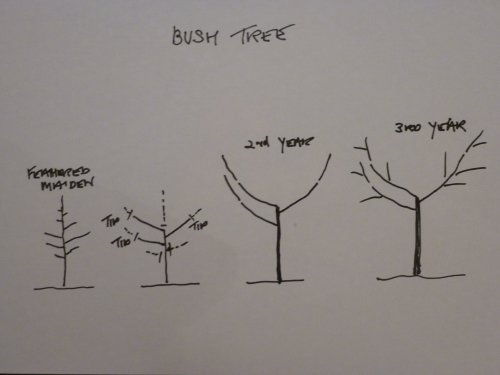
SPINDLE BUSH - CENTRE LEADER TREE.
The advent of centre leader trees as the Spindle Bush started on the continent during the 1950's. The Golden Delicious, adopted by the French for their expatriates from Algeria as the basis for an intensive, high production apple industry popularised the spindle bush format.
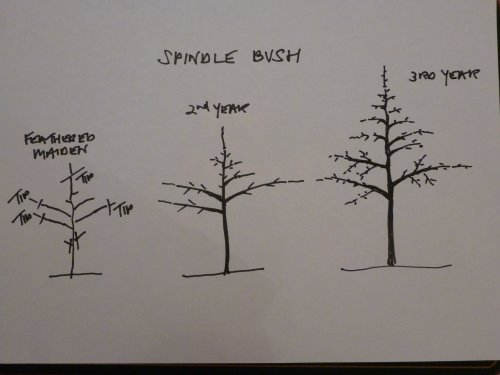
INTENSIVE SINGLE ROW ORCHARDS - FRUIT WALLS.
In the last 20 years, growers on the continent (Europe) have moved away from the Spindle Bush towards an ever more intensive 'Single Row Format'
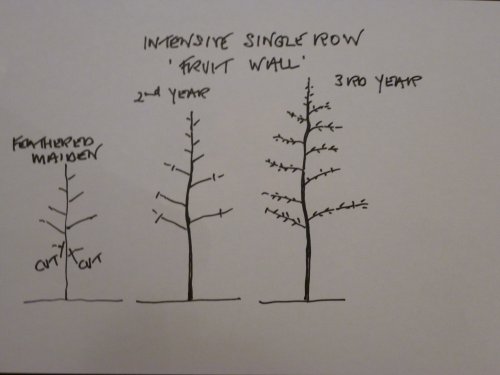
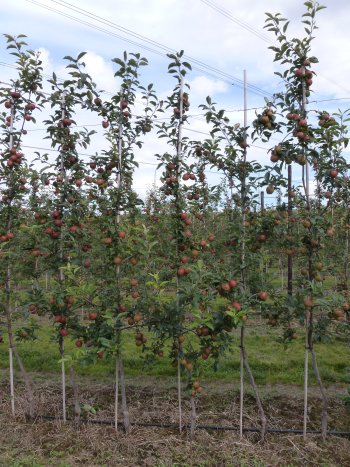
Cropping Units!
The characteristics of different varieties is integral to the cropping habit & potential. Cox is the epitome of a variety that crops on two year wood. Gala is the epitome of varieties which crop on one year old wood and Bramley & Discovery the most prominent of the 'tip bearers'
For a more detailed explanation of pruning systems Visit The English Apple Man Journal for 29th January 2010.
JOHN BREACH
 John Breach & Huxley Orchards: Fate intervenes in all our lives from time to time; it was fortuitous that back in October 2009, John Breach made a generous offer of £1,000 worth of trees to one lucky winner in a prize draw designed to stimulate interest in new orchard planting.
John Breach & Huxley Orchards: Fate intervenes in all our lives from time to time; it was fortuitous that back in October 2009, John Breach made a generous offer of £1,000 worth of trees to one lucky winner in a prize draw designed to stimulate interest in new orchard planting.
Looking back to that year, it was indeed 'fate' that Theresa Huxley was the recipient of John's innovative generosity. Had a grower won this prize, no doubt the trees would be growing unheralded in a corner of an orchard, 'somewhere in the South, East or West of our UK growing regions.
When Theresa won the prize, her imagination and drive took over; a plan to donate an eclectic mix of apple & pear trees for educational purposes came into being, when she offered the trees to Hadlow College for the practical benefit of the Horticultural Students education.
March 2010; HUXLEY 1 was born!
 John Breach's generosity took a second step forward in 2012 when he donated 250 of his CHEERFULL GOLD trees for a second Huxley Training orchard. This came to life in March 2012 at Pershore College and within weeks another 250 CHEERFULL GOLD were planted at Hadlow College. Huxley 3 was born!
John Breach's generosity took a second step forward in 2012 when he donated 250 of his CHEERFULL GOLD trees for a second Huxley Training orchard. This came to life in March 2012 at Pershore College and within weeks another 250 CHEERFULL GOLD were planted at Hadlow College. Huxley 3 was born!
While HUXLEY 1 is a mix of varieties of Apples & Pears, exposing students to the very different characteristics of Cox, Breaburn, Gala, etc etc... HUXLEY 2 & 3 are full blocks of CHEERFULL GOLD (with appropriate pollinators) but once again John Breach's innovative imagination took over and a very well thought out systems trial became the driver for each orchard. The dual benefit of Student Education and Systems Trials will bring benefits to the Students fortunate enough to work in the two orchards and the Growers who plant CHEERFULL GOLD will gain valuable data from the systems trial.
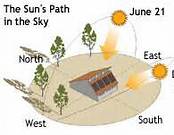 One very innovative trial, a product of John Breach's imagination, is The Sunny Side Spindles. Light is the key to maximising yield and quality and the much coined phrase; " we are harvesting light" is the basis of every orchard planner's design.
One very innovative trial, a product of John Breach's imagination, is The Sunny Side Spindles. Light is the key to maximising yield and quality and the much coined phrase; " we are harvesting light" is the basis of every orchard planner's design.
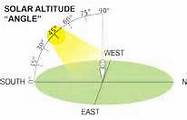 John recognised the base rule for all orchards, is to orientate rows North to South, ensuring the spread of the Sun throughout the day, delivers equal light to both sides of the rows. However the Sunny Side format is designed to aim the cropping area as directly as possible at the light source; our Sun!
John recognised the base rule for all orchards, is to orientate rows North to South, ensuring the spread of the Sun throughout the day, delivers equal light to both sides of the rows. However the Sunny Side format is designed to aim the cropping area as directly as possible at the light source; our Sun!
Taking the example of Solar Farming, where the photovoltaic panels are clearly sited to maximise the available sunlight, John has designed a tree format that is designed to duplicate that concept.
The illustrations below, mirror the North-South orientation at Pershore.
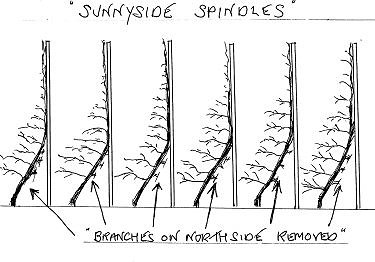
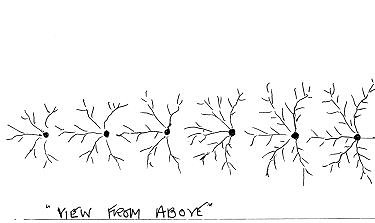
While the orientation of the trees in the Sunnyside plot at Pershore is North - South, the orientation at Hadlow is East - West. Not planned purely down to the site location, BUT as so often this may prove to be fortuitous with the probability that E/W orientation may actually maximise the light interception versus N/S.
John Breach summarises the Sunny Side system.
"The Sunny-Side system was conceived as an experiment to see if the colour grade-out of bi-coloured apples (Gala, Braeburn etc.) could be improved by optimising the available sunlight and by reducing the quantity of fruits growing 'in the shade' The system is based on;: planting each tree approximately 30cm to the south of the tree stake (or the line of wire-work, if used instead of individual stakes - on the East - West orientated rows).
By tilting the top of the tree to the North; fixing the tree to the top of the stake; then removing all the 'North' facing branches. In subsequent years, pruning involves removing any new North facing branches, together with any that are too low, or crossing. As the canopy thickens and becomes more dense, pruning to ensure fruit bud quality is maintained will require selective removal of stronger wood/branches"
The general consensus at Hadlow last week was the Sunny-Side system lends itself to the use of mechnical pruning.
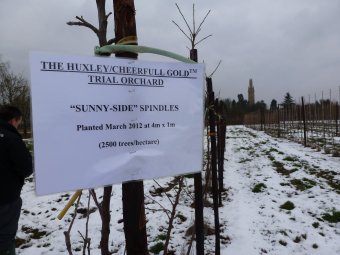
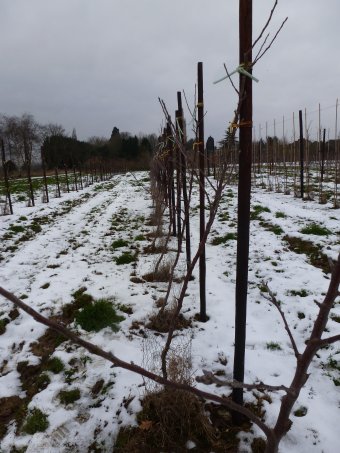
Practical pruning demonstrations.
Once into the orchards, students formed groups and came under the practical guidance of Roger Worraker, Malcolm Withnall and Brian Thompsett; Brian has recently retired from his role as Orchards Manager for N&A Bardsley, and his consumate practical knowledge gained over his 40+ years in the fruit industry was an invaluable asset to the pruning day at Hadlow. In his time in the industry Brian has gained experience with all growing systems and most importantly, is fully up to speed with the latest orchard system; e.g. Fruit Walls!
Trees with a defined base structure; e.g. 3 - 4 base branches and a central leader, which act as a host for the fruiting laterals and require a policy of renewal. This tree shape; essentially Spindle Bush should carry circa 85% of the fruit on the fruiting laterals on the base structure and 15% on the central leader.
The HUXLEY 1,Orchard has a selection of varieties, with varying characteristics which require different pruning requirements. In the pictures below, Roger, Malcolm and Brian demonstrate the importance of keeping the tree in balance. this requires shaping the tree to ensure light interception, removing any branch displaying strong 'upward' growth, and dealing with the leader (top of tree) to maintain balanced vigour. Of course, the best control agent is a tree cropping to its full potential.
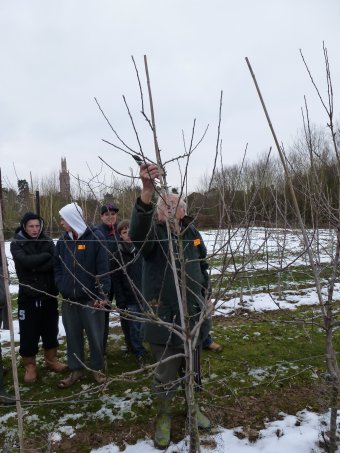
In the pictures below, Brian is pruning the young Cheerfull Gold trees (planted last March-2012) and where the tree has not made enough growth; 'last summer was wet and cold' and many young orchards have not grown as we might have hoped. Here Brian cuts the previous (2012) summer's growth back to the point of growth (the growth ring) to stimulate growth in the second summer (2013)
In the next two pictures, Brian is dealing with a vigorous upwards branch in a 3 year old tree, which if left in the tree would dominate the surrounding fruiting branches. Left in; the branch would ruin the balance of the tree. Ideally of course; this branch should have been removed before it became a problem.
After instruction from Roger, Malcolm and Brian, students get to work. 'albeit nervously' in HUXLEY 1, the three year old trees.
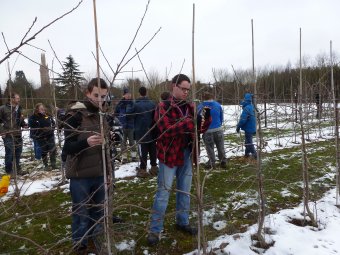
The English Apple Man summarizes!
The generosity of John Breach, the committment of Theresa Huxley and the combined efforts of growers and fruit experts has given the students of Hadlow & Pershore Colleges a superb practical opportunity to enhance the education of horticultural students, and in particular those with the ambition to make a career in the UK Top Fruit industry.
It is a responsibility of us all to make sure this opportunity is capitalised upon for the future benefit of our young people, our industry AND our consumers who will have access to an increasing variety and volume of high quality English grown Apples & Pears.
Until next week..............................
Take care
The English Apple Man
 Finishing on a very personal note; my wife and I entertained our good friends Diana & David Rowe for lunch yesterday. Last summer, David who in retirement is blossoming as an artist, painted a picture of 'POPPY' our Cocker Spaniel and in conversation we learnt of a website he is involved in for local artists in East Sussex.
Finishing on a very personal note; my wife and I entertained our good friends Diana & David Rowe for lunch yesterday. Last summer, David who in retirement is blossoming as an artist, painted a picture of 'POPPY' our Cocker Spaniel and in conversation we learnt of a website he is involved in for local artists in East Sussex.